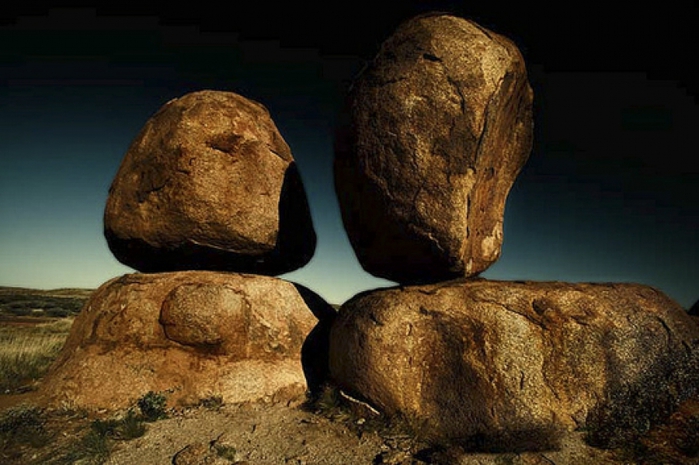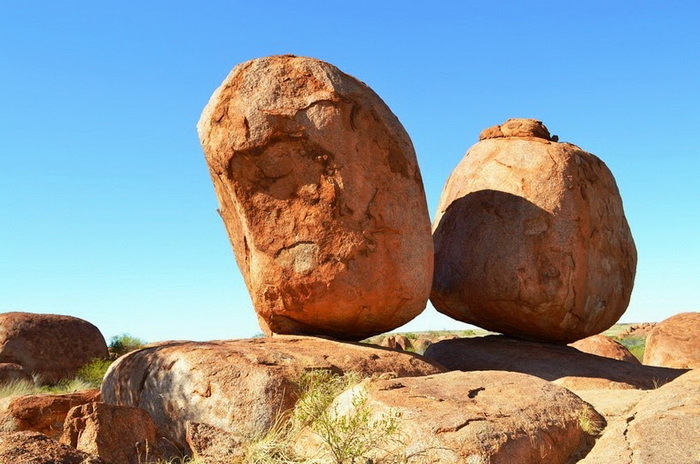Karlu Karlu / Devils Marbles Conservation Reserve is located 105 km (65 mi) south of Tennant Creek, Northern Territory, Australia and 393 km (244 mi) north of Alice Springs. The nearest settlement is the small town of Wauchope located 9 km (5.6 mi) to the south.
The Devils Marbles are of great cultural and spiritual significance to the traditional Aboriginal owners of the land, and the reserve protects one of the oldest religious sites in the world as well as the natural rock formations found there. Karlu Karlu is the local Aboriginal term for both the rock features and the surrounding area. The Aboriginal term translates as round boulders and refers to the large boulders found mainly in the western side of the reserve. The origin of the English name for the same boulders is the following quote:
This is the Devil’s country; he’s even emptied his bag of marbles around the place! - John Ross, Australian Overland Telegraph Line expedition, 1870
The area was originally named Devils Marbles Reserve in October 1961. The name was changed to Devil's Marbles Conservation Reserve on 21 September 1979 under the Territory Parks and Wildlife Conservation Act. In 1982, almost the entire reserve was registered as a sacred site by the Aboriginal Areas Protection Authority.
Ownership of Karlu Karlu/Devils Marbles was officially passed from the Parks and Wildlife Service of the Northern Territory back to the Traditional Owners at a ceremony held on the reserve in October 2008. The reserve is now leased back to the Parks Service under a 99-year lease and the site is jointly managed by rangers and Traditional Owners. Visitor access has not been affected. On 6 July 2011, the name Karlu Karlu / Devils Marbles Conservation Reserve was assigned, corresponding with the joint management structure.
The Devils Marbles are large granitic boulders that form the exposed top layer of an extensive and mostly underground granite formation. The natural processes of weathering and erosion have created the various shapes of the boulders. Some of the boulders are naturally but precariously balanced atop one another or on larger rock formations, while others have been split cleanly down the middle by natural forces. The boulders are situated in a wide and shallow desert valley, and are found in scattered groups mainly in the western side of the reserve. A short access road leads directly into the boulder fields from the Stuart Highway.
Being one of the most widely recognised symbols of Australia’s outback, the Devils Marbles are also one of the most visited reserves in the Northern Territory. The Parks and Wildlife Service recorded 96,172 visitors in 2007. The visitation count increased to 137,500 by 2012. The peak season is in the cooler months from May to August. The reserve is one of the main tourist attractions in the Barkly region since it is easily seen and accessed just off the Stuart Highway, the major north/south road connecting Darwin and Alice Springs, and points further south.
The Devils Marbles are accessible all year round with a network of pathways, information boards and a basic camping area. Rangers offer a program of live events at the site as part of their Territory Parks Alive program between May and September each year.
One of the boulders was removed from the reserve in 1952 and taken to Alice Springs to form a memorial to John Flynn, the founder of the Royal Flying Doctor Service. The boulder was chosen as a symbol of his link to the outback, but it became the source of a lengthy controversy. The boulder had unwittingly been removed from a sacred site of the Aboriginal women of the area. Eventually, after more than 45 years of negotiations, a boulder swap was arranged and the sacred boulder was removed from the grave and returned to its original place on 4 September 1999. The grave is now marked with a similar but non-sacred boulder donated by the Arrernte people.













